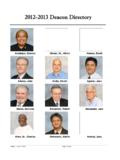Transcription of BY ARTHUR MILLER - Home - Shaw Festival Theatre
1 STUDY GUIDE 2006 A PRACTICAL, HANDS-ON RESOURCE FOR THE CLASSROOM CONTAINING ONTARIO CURRICULUM SUPPORT MATERIALS EDUCATION PARTNERS BY ARTHUR MILLER 2 PRESENTS The crucible By ARTHUR MILLER TABLE OF Contents The The Story ..4 Who s Who in the Play ..5 Director s Notes/Designer s Notes ..6 The Playwright ..7 Historical Did You Know? ..9 Background/ Puritanism ..10 Background/The Mystery of Salem ..11 Background/The Political Stage ..12 Additional Classroom Applications Before Attending the Play .. 14-20 After Attending the 21-28 Glossary of Theatre Terms ..29 Response Sheet ..30 The crucible Running time: 2hrs 50 approx. including one intermission Previews June 3, 2006 Opens June 23, 2006 Closes October 14, 2006 This study guide for The Crucible contains back-ground information for the play, suggested themes and topics for discussion, and curriculum-based lessons that are designed by educators and Theatre professionals.
2 The lessons and themes for discussion are organ-ized in modules that can be used independently or interdependently according to the class level and time availability. THIS GUIDE WAS WRITTEN AND COMPILED BY BARBARA WORTHY, ROD CHRISTENSEN AND DR. DEBRA MCLAUCHLAN, PHD. ADDITIONAL MATE-RIALS WERE PROVIDED BY TADEUSZ BRADECKI, PETER HARTWELL AND GYLLIAN RABY. COVER: LOOKING BACK (1984) EVELYN WILLIAMS, CHARCOAL ON PAPER.(PRIVATE COLLECTION/BRIDGEMAN ART LIBRARY) PAGE 2 ILLUSTATION: DEATH WARRANT FOR REBECCA NURSE (ORIGINAL COURT DOCUMENT) PAGE 5 PHOTO: PETER KRANTZ BY SHIN SUGINO. 3 The Players Ezekiel Guy Bannerman Giles Corey ..Bernard Behrens Anthony Bekenn Lisa Berry Thomas Putnam .. Norman Browning John Proctor .. Benedict Campbell Betty Katie Cambone-Mannell Elizabeth Proctor.
3 Kelli Fox Abigail Williams ..Charlotte Gowdy Ann Haney Townsperson ..Evert Houston Francis Nurse ..Al Kozlik Reverend John Krantz Mary Trish Lindstrom Marshall Jeff Meadows Deputy-Governor Jim Mezon Rebecca Jennifer Phipps Micheal Querin Reverend Samuel Ric Reid Judge Hathorne .. David Schurmann Susanna Wallcott ..Nelly Scott Sarah Good .. Wendy Thatcher Mercy Taylor Trowbridge Directed by Tadeusz Bradecki Set Designed by Peter Hartwell Costumes Designed by Teresa Przybylski Lighting Designed by Kevin Lamotte Original Music by Paul Sportelli Stage Manager: Meredith Macdonald Assistant Stage Manager: Amy Jewell Technical Director: Jeff Scollon Synopsis A powerful, fictional re-telling of a historical moment in 17th century America: the witch trials of Salem, Massachusetts in 1692.
4 A play famous for rousing the conscience of America, and one of the landmark dramas of the century, it depicts how difficult it is to defend principles and human dignity under conditions of para-noia, fear, and hysteria. The Crucible is an allegory of the insidious spread and reach of McCarthyism in the early 50s. 4 The Crucible is based upon the 17th century witch-hunts that took place in the community of Salem - a small religious colony of Puritans near Boston, Massachusetts. MILLER wrote this play as an allegory to 1950s McCarthyism; it parallels the activities of the House Of Un-American Activities Committee in the USA during the mid 20th century when para-noia about communism pervaded the USA and spread to Canada. The Crucible is a story of a village overtaken by religious fervor and mounting panic, where people are arrested for being witches with-out evidence.
5 In Salem, matters of good and evil are clearly defined; dissent is not merely unlawful, it is associated with satanic activity. Early in the year of 1692, a collection of girls from the colony fall victim to supposed hallucinations and seizures after dancing in the forest with a black female slave named Tituba. Suspicion surrounds Tituba and soon accusations and fears of witch-The Story Death Warrant for Rebecca Nurse (Original court document) craft fill the town. Abigail Williams, 17 years old and beautiful, appears to be the girls ringleader, and when Tituba and Abigail begin accusing vari-ous townsfolk of conspiring with the devil, the other girls join in. Soon the colony is beset with jealousies, bitter quarrellings, and deeply held ha-treds rise to the surface.
6 Local farmer John Proctor is a deeply honest man and he suspects Abigail of being a fraud. But Proctor has a guilty secret to protect an affair with Abigail when she was a ser-vant in his house. This proves to be his downfall. Jealous and vindictive, Abigail accuses Proctor s wife of dealings with the devil, and as the hysteria grows, Proctor hesitates to expose Abigail in fear of having his secret exposed and losing his good name. Old grudges and religious fervour result in tragedy, as good people are hanged for witchcraft, others are jailed, and a community is left with its conscience in tatters. Costume design for John Proctor by Teresa Przybylski. 5 Who s WhoElizabeth Proctor is a good woman who has been treated badly and she pays the ultimate price.
7 Her love and understanding of her husband John is powerful, but if she accepted his adultery, she did not intend to let it continue. She is no fool and under-stands Abigail s intentions well, better than Proctor himself. She is a loving mother, and is sent to prison even though she carries a child. She is described as being cold, but is perhaps merely accept-ing of her life. At the center of the Salem tragedy were real people - the bewitched young girls, the towns people who fell prey to the hysteria and the innocent individuals accused of witchcraft. Whether they helped create the witch-hunt or were at the mercy of the events, these people made up a community consumed by jealousy, fear, hysteria, superstition and hypocrisy. Abigail Williams is a tormented charac-ter who represents absolute evil and The Devil.
8 She is the mass murderer whose actions bring about the death of so many innocent people. She was deeply in love with John Proctor and now that love has been taken away from her, her vengeance is powerful. She wants revenge. But her life is not an easy one. She is an orphan whose parents were murdered by the Wabanaki, (see pg. 9). She has raised herself, feeling some-what on the edge of society, and observing all the manipulation and hypocrisy around her. Her power comes from her intelligence, empathy and courage. She s like an animal, instinctual and strong. She knows what she has to do to get what she wants. John Proctor is a deeply honest man, who is troubled by his act of lechery with Abigail. Driven by guilt , Proctor be-comes the hero of this play, but he is painfully human.
9 His fall from grace is part of his humanity. He is weak and unde-cided, full of contradictions, and yet he makes heroic choices. He is a man who can be easily understood because he is imperfect. Part of this imperfection is the knowledge that his bond with Abigail is not completely ended. His choices are difficult but in the end, heroic. Deputy-Governor Danforth is the Deputy Gover-nor of Massachusetts and the presiding judge at the witch trials. Honest and scrupulous, Danforth is a tough Boston lawyer who is basically fair, honest and scrupulous but overconfident in his ability to judge the truth. He is always right, at least in his own mind, and is convinced that he is doing right in rooting out witchcraft. Danforth feels that it is his duty and destiny to purge society of evil and establish the Kingdom of Christ on earth.
10 He is, therefore, temperamentally inclined to interpret all evidence as proof that Satan's forces are operating in Salem and seems to feel particularly strongly that the girls are honest. He is sensitive to the presence of the devil and reacts explosively to whatever evidence is presented. Reverend Parris is Pastor of the church in Salem. He is the father of Betty, uncle of Abigail Williams, and master of Tituba. He believes that he is being persecuted and that the townspeople do not respect his position as a man of God. The people have ousted the last few pastors and Parris fears the same fate. He chooses to believe the girls, because to do otherwise would mean that the trouble would be connected to his own household. If this happened, he may not be trusted by the village. Reverend John Hale is a tight-skinned, eager-eyed intellectual.










